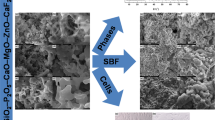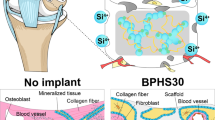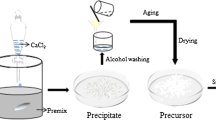Abstract
Osteoproductive materials that induce quick bone regeneration are needed for the developing area of scaffold-based bone engineering. Bioactive silica-based glasses, ceramics, and hybrids are called to play an important role in this field. Organic–inorganic hybrid materials based on SiO2-modified PDMS–P2O5–CaO are studied in this work. These materials are synthesized by the sol–gel method, and the influence of the composition on the reaction kinetic, obtained porosities, degradation and bioactive behavior, and cytotoxicity is studied. Materials with greater contents in CaO yield faster reaction kinetics and produce porous materials that favor a quicker degradation, whereas with greater P2O5 contents produce denser and more stable materials. The incorporation of CaO and P2O5 up to 5 and 25 % in weight into the SiO2 network, respectively, resulted in an increase of the apatite-forming ability in PBS. None of the studied compositions are cytotoxic, showing cellular viability over 70 % at all times.











Similar content being viewed by others
References
Sayed AA, Agarwal M, Giannoudis PV, Matthews SJE, Smith RM (2004) Distal femoral fractures: long term outcome following stabilization with the LISS. Injury 35:599–607
Zhao G, Zinger O, Schwartz Z, Wieland M, Landolt D, Boyan BD (2006) Osteoblast-like cells are sensitive to submicron-scale surface structure. Clin Oral Implant Res 17(3):258–264
Miyazaki T, Kamitakahar M, Ohtsuki C (2009) Chapter 16: development of bioactive organic-inorganic hybrids through sol-gel processing. In: Merheri L (ed) Hybrid nanocomposites for nanotechnology. Springer Science + Business Media, LLC, New York, pp 769–793
Yang Y, Kang Y, Sen M, Park S (2011) Chapter 7: bioceramics in tissue engineering. In: Burdick JA, Mauck RL (eds) Biomaterials for tissue engineering applications. Springer, Wien, pp 179–207
Rodríguez-Lorenzo LM (2014) Functionalized apatite nanocrystals for biomedical applications. In: Lafisco M, Delgado-López JM (eds) Apatite: synthesis, structural characterization and biomedical applications. NOVA Publishers, New York, pp 261–290
Dorozhkin SV (2009) Calcium orthophosphate-based biocomposites and hybrid biomaterials. J Mater Sci 44:2343–2387
Dorozhkin SV (2010) Bioceramics of calcium orthophosphates. Biomaterials 31:1465–1485
Hesaraki S, Alizadeh M, Nazarian H, Sharifi D (2010) Physico-chemical and in vitro biological evaluation of strontium/calcium silicophosphate glass. J Mater Sci Mater Med 21:695–705
Lee KY, Lee YH, Kim HM, Koh MY, Ahn SH, Lee HK (2005) Synthetic model of a bioactive functionally graded nano-hybrid in silica-polydimethylsiloxane system. Curr Appl Phys 5:453–457
Sánchez-Téllez DA, Téllez-Jurado L, Chávez-Alcalá JF (2014) Bioactivity and degradability of hybrids nano-composites materials with great application as bone tissue substitutes. J Alloys Compd 615(1):670–675
Brinker CJ, Scherer GW (1990) Sol-gel science: the physics and chemistry of sol-gel processing edit. Academic Press Inc. An Imprint of Elsevier, New York. ISBN.-13:978-0-12-134970-7
D’Apuzzo M, Aronne A, Esposito S, Pernice P (2000) Sol-gel synthesis of humidity-sensitive P2O5-SiO2 amorphous films. J Sol-Gel Sci Tech 17:247–254
Ma J, Chen CZ, Wang DG, Meng XG, Shi JZ (2010) Influence of the sintering temperature on the structural feature and bioactivity of sol-gel derived SiO2-CaO-P2O5 bioglass. Ceram Int 36:1911–1916
Almeida JC, Castro AGB, Lancastre JJH, Miranda Salvado IM, Margaca FMA, Fernandes MHV, Ferreira LM, Casimiro MH (2014) Structural characterization of PDMS-TEOS-CaO-TiO2 hybrid materials obtained by sol-gel. Mater Chem Phys 143:557–563
Téllez L, Rubio J, Rubio F, Morales E, Oteo JL (2004) FT-IR study of the hydrolysis and polymerization of tetraethyl orthosilicate and polydimethyl siloxane in the presence of tetrabutyl orthotitanate. Spectrosc Lett 37:11–31
Salinas AJ, Merino JM, Babonneau F, Gil FJ, Vallet-Regí M (2007) Microstructure and macroscopic properties of bioactive CaO-SiO2-PDMS hybrids. J Biomed Mater Res B 81B:274–282
Whang C, Seo D, Oh E, Kim Y (2005) Compositional dependence of apatite formation in sol-gel derived organic-inorganic hybrids. Glass Phys Chem 31(3):396–401
Vallet-Regí M, Salinas AJ, Ramírez-Castellanos J, González-Calbet JM (2005) Nanostructure of bioactive sol-gel glasses and organic-inorganic hybrids. Chem Mater 17:1874–1879
Sava BA, Elisa M, Vasiliu LC, Nastase F, Simon S (2012) Investigation on sol-gel process and structural characterization of SiO2-P2O5 powders. J Non-Cryst Solids 358:2877–2885
Padilla S, Román J, Carenas A, Vallet-Regí M (2005) The influence of the phosphorus content on the bioactivity of sol-gel glass ceramics. Biomaterials 26:475–483
Massiot Ph, Centeno MA, Carrizosa I, Odriozola JA (2001) Thermal evolution of sol-gel-obtained phosphosilicate solids (SiPO). J Non-Cryst Solids 292:158–166
Fernández-Navarro JM (1991) El vidrio. Edit. Consejo Superior de Investigaciones Científicas. Fundación Centro Nacional del Vidrio. 2nd edn, Spain. ISBN: 84-00-07130-1
Glaser RH, Wilkes GL, Bronnimann CE (1989) Solid state 29Si NMR of TEOS-based multifunctional sol-gel materials. J Non-Cryst Solids 113:73–87
Neeraj Eswaramoorthy M, Rao CNR (1998) Mesoporous silicophosphate. Mater Res Bull. 33(10):1549–1554
Carta D, Newport RJ, Knowles JC, Smith ME, Guerry P (2011) Sol-gel produced sodium calcium phosphosilicates for bioactive applications: synthesis and structural characterization. Mater Chem Phys 130:690–696
Brow RK (2000) Review: the structure of simple phosphate glasses. J Non-Cryst Solids 263&264:1–28
Siqueira RL, Zanotto ED (2011) Facile route to obtain a highly bioactive SiO2-CaO-Na2O-P2O5 crystalline powder. Mater Sci Eng C 31:1791–1799
Saboori A, Rabiee M, Moztarzadeh F, Sheikhi M, Tahriri M, Karim M (2009) Synthesis, characterization and in vitro bioactivity of sol-gel-derived SiO2-CaO-P2O5-MgO bioglass. Mater Sci Eng C 29:335–340
Mozafari M, Moztarzadeh F, Tahriri M (2010) Investigation of the physico-chemical reactivity of a mesoporous bioactive SiO2-CaO-P2O5 glass in simulated body fluid. J Non-Cryst Solids 356:1470–1478
Tatai L, Moore TG, Adhikari R, Malherbe F, Jayasekara R, Griffiths I, Gunatillake PA (2007) Thermoplastic biodegradable polyurethanes: the effect of chain extender structure on properties and in vitro degradation. Biomaterials 28:5407–5417
John A, Mani S, Gopalakrishnam S, Babu S, Lal AV, Varma H (2011) Osteogenesis of a bioactive ceramic-calcium phosphosilicate composite system in goat femur defect. Int J Appl Ceram Technol 8(3):491–500
Jiménez-Gallegos R, Téllez-Jurado L, Rodríguez-Lorenzo LM, San Román J (2011) Modulation of the hydrophilic character and influence on the biocompatibility of polyurethane-siloxane based hybrids. Bol Soc Esp Ceram Vidr 50(1):1–8
Huang K, Cai S, Xu G, Ye X, Dou Y, Ren M, Wang X (2013) Preparation and characterization of mesoporous 45S5 bioactive glass-ceramic coatings on magnesium allow for corrosion protection. J Alloys Compd 580:290–297
Kim IY, Kawachi G, Kikuta K, Cho SB, Kamitakahara M, Ohtsuki C (2008) Preparation of bioactive spherical particles in the CaO-SiO2 system through sol-gel processing under coexistence of poly(ethylene glycol). J Eur Ceram Soc 28:1595–1602
Gunatillake PA, Adhikari R (2003) Biodegradable synthetic polymers for tissue engineering. Eur Cells Mater 5:1–16
Guana J, Fujimotoa KL, Sacksa MS, Wagnera WR (2005) Preparation and characterization of highly porous, biodegradable polyurethane scaffolds for soft tissue applications. Biomaterials 26:3961–3971
Sabino M, Núñez O, Müller J (2002) Evidencias Espectroscópicas de la Degradación Hidrolítica de la Poli(dioxanona). Rev Latinoam de Metal y Mater 22(2):40–51
Miyata N, Fuke K, Chen Q, Kawashita M, Kokubo T, Nakamura T (2004) Apatite-forming ability and mechanical properties of PTMO modified CaO–SiO2–TiO2 hybrids derived from sol-gel processing. Biomaterials 25:1–7
Chikara O, Miyazaki T, Tanihara M (2002) Development of bioactive organic-inorganic hybrid for bone substitutes. Mater Sci Eng C 22:27–34
Sastre R, de Aza S, San Román J (2001) Biomateriales. Edit. CYTED Programa Iberoamericano de Ciencia y Tecnología para el Desarrollo, Italy. ISBN: 84-87683-26-6
Sadat-Shojai M, Khorasani M-T, Dinpanah-Khoshdargi E, Jamshidi A (2013) Review: synthesis methods for nanosized hydroxyapatite with diverse structures. Acta Biomater 9:7591–7621
Kim H-M, Himeno T, Kokubo T, Nakamura T (2005) Process and kinetics of bonelike apatite formation on sintered hydroxyapatite in a simulated body fluid. Biomaterials 26(21):4366–4373
Ragel CV, Vallet-Regí M, Rodríguez-Lorenzo LM (2002) Preparation and in vitro bioactivity of hydroxyapatite/sol gel-glass biphasic material. Biomaterials 23(8):1865–1872
Ohtsuki C, Miyazaki T, Kamitakahara M, Tinihara M (2007) Design of novel bioactive materials through organic modification of calcium silicate. J Eur Ceram Soc 27:1527–1533
Mami M, Lucas-Girot A, Oudadesse H, Dorbez-Sridi R, Mezahi F, Dietrich E (2008) Investigation of the surface reactivity of a sol gel derived glass in the ternary system SiO2-CaO-P2O5. Appl Surf Sci 254:7386–7393
Acknowledgements
This work was supported by DGICT Project, MAT2014-51918-C2-1-R, Spain, and SIP-IPN 20140064 Project, Mexico. DA Sánchez-Téllez also acknowledges CONACYT for the scholarship.
Author information
Authors and Affiliations
Corresponding author
Rights and permissions
About this article
Cite this article
Sánchez-Téllez, D.A., Téllez-Jurado, L. & Rodríguez-Lorenzo, L.M. Optimization of the CaO and P2O5 contents on PDMS–SiO2–CaO–P2O5 hybrids intended for bone regeneration. J Mater Sci 50, 5993–6006 (2015). https://doi.org/10.1007/s10853-015-9147-1
Received:
Accepted:
Published:
Issue Date:
DOI: https://doi.org/10.1007/s10853-015-9147-1




